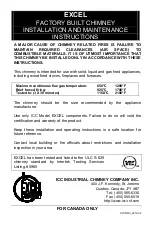
Section: PREPARE THE APPLIANCE
14
Prepare the Appliance
Breathing Hazard
Ceramic fiber or Fiberglass insulation
Ceramic fiber materials, such as chamber
liners, may contain carcinogenic particles
(crystalline silica) after exposure to
heat. Airborne particles from fiberglass
or ceramic fiber components have
been listed as potentially carcinogenic by the State
of California. Take the following precautions when
removing, replacing and handling these items.
Avoid breathing dust and avoid contact with skin
or eyes
. Wear long-sleeved, loose-fitting clothing,
gloves and eye protection. Use a NIOSH N95 certified
respirator. This respirator meets requirements
for protection from crystalline silica. Actual job
requirements for NIOSH regulations may require
other or additional protection. For information, refer
to the NIOSH website,
http://www.cdc.gov/niosh/
homepage.html
.
Ceramic fiber removal:
To prevent airborne dust,
thoroughly wet ceramic fiber with water before
handling. Place ceramic fiber materials in a plastic bag
and seal to dispose.
Avoid blowing, tearing, sawing or spraying
fiberglass or ceramic fiber materials. If such operations
are necessary, wear extra protection to prevent
breathing dust.
Wash work clothes separately from other laundry
.
Rinse clothes washer thoroughly afterwards to prevent
contamination of other clothing.
NIOSH First aid procedures:
•
Eye exposure - irrigate eyes immediately
•
Breathing - fresh air
Asbestos Hazard
NEVER attempt to retrofit an
appliance containing asbestos.
Contact a professional to remove
the asbestos prior to installation. If
unsure call a qualified contractor to
verify if asbestos is present.
Carbon Monoxide
Hazard
Burner mounting gasket must be used to seal against
leakage from the appliance. Do not use a damaged
mounting gasket. Verify that all boiler sections, canopy,
and access plates or doors are fully equipped with
gaskets and sealed against any leakage.
Mount the Burner
The burner specified for packaged equipment will
have a flange to match the appliance bolt pattern and
welded for the required insertion. Follow the appliance
manufacturer’s instructions for mounting.
Carbon Monoxide
Hazard
Protect the Air Tube from Overheating.
Overheating could cause damage to the air tube
and other combustion components leading to
equipment malfunction and impaired combustion
performance.
•
The end of the air tube must not extend into
the combustion chamber unprotected unless
it has been factory-tested and specified by the
appliance manufacturer.
•
The end of the air tube should be set back ¼”
from flush with the refractory inside wall to
prevent damage from overheating.
•
Refer to the instructions outlined in this section
for methods of additional protection.
Explosion, Fire, and
Asphyxiation Hazard.
Adjustable flange shall not be used with portable
equipment.
For retrofit applications and to ensure correct installation,
verify the following:
|
Verify the end of the burner air tube will be set back
1/4” from the interior surface of the combustion
chamber when the burner is mounted to the
.
|
If this dimension cannot be achieved, protect the
end of the air tube by installing a suitable ceramic
refractory material such as a refractory mill board
capable of withstanding at least 2300°F.
|
Verify the burner flame size is suitable for the
appliance combustion chamber. See
for
minimum combustion chamber dimensions at the
stated firing rate ranges.
Dimensions shown are for
cast iron sectional boilers
with uptakes between sections. For minimum
dimensions of other furnace types consult R.W.
Beckett Corporation.
|
Verify the supplied gasket is in place on the burner
air tube flange and then mount the burner to the
appliance using appliance or field supplied hardware.















































